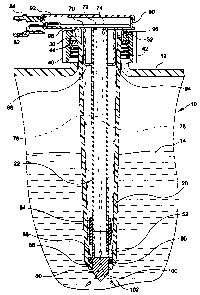Some of the information on this Web page has been provided by external sources. The Government of Canada is not responsible for the accuracy, reliability or currency of the information supplied by external sources. Users wishing to rely upon this information should consult directly with the source of the information. Content provided by external sources is not subject to official languages, privacy and accessibility requirements.
Any discrepancies in the text and image of the Claims and Abstract are due to differing posting times. Text of the Claims and Abstract are posted:
| (12) Patent: | (11) CA 2289035 |
|---|---|
| (54) English Title: | LIQUID LEVEL SENSOR FOR USE IN A HOT, PRESSURIZED LIQUID |
| (54) French Title: | JAUGE DE NIVEAU POUR LIQUIDES CHAUDS SOUS PRESSION |
| Status: | Expired and beyond the Period of Reversal |
| (51) International Patent Classification (IPC): |
|
|---|---|
| (72) Inventors : |
|
| (73) Owners : |
|
| (71) Applicants : |
|
| (74) Agent: | MOFFAT & CO. |
| (74) Associate agent: | |
| (45) Issued: | 2007-01-09 |
| (86) PCT Filing Date: | 1998-03-25 |
| (87) Open to Public Inspection: | 1998-11-19 |
| Examination requested: | 2002-12-11 |
| Availability of licence: | N/A |
| Dedicated to the Public: | N/A |
| (25) Language of filing: | English |
| Patent Cooperation Treaty (PCT): | Yes |
|---|---|
| (86) PCT Filing Number: | PCT/US1998/005958 |
| (87) International Publication Number: | WO 1998052014 |
| (85) National Entry: | 1999-10-29 |
| (30) Application Priority Data: | ||||||
|---|---|---|---|---|---|---|
|
In a preferred embodiment, a liquid level sensor (10) for use
in a hot, pressurized liquid (14), including: an outer housing (20)
suitable for immersion in liquid (14); an inner housing (22) disposed
within outer housing (20) and containing therein electronic/electrical
components (70); detection apparatus (74) disposed within outer
housing (20) and inner housing (22) to detect the level of liquid (14);
a space defined between outer housing (20) and inner housing (22);
and means (98) to permit liquid (14) which migrates through a wall
of outer housing (20) into the space and which is vaporized therein to
pass to the ambient surroundings, so as to preclude migration of the
liquid through a wall of inner housing (22).
L'invention porte sur une jauge de niveau (10) pour liquides (14) chauds sous pression comportant une enveloppe extérieure (20) conçue pour être plongée dans le liquide (14), une enveloppe intérieure (22) placée dans l'enveloppe extérieure (20) et contenant des composants (70) électroniques et électriques, un appareil de détection (74) placé dans l'enveloppe extérieure (20) et l'enveloppe intérieure (22) et servant à mesurer le niveau de liquide (14), un espace compris entre le logement extérieur (20) et le logement intérieur (22), et des moyens (98) permettant au liquide (14), migrant à travers une paroi de l'enveloppe extérieure (20) vers l'espace intermédiaire où il se vaporise, de rejoindre l'atmosphère environnante afin d'empêcher la migration du liquide à travers une paroi de l'enveloppe intérieure (22).
Note: Claims are shown in the official language in which they were submitted.
Note: Descriptions are shown in the official language in which they were submitted.

2024-08-01:As part of the Next Generation Patents (NGP) transition, the Canadian Patents Database (CPD) now contains a more detailed Event History, which replicates the Event Log of our new back-office solution.
Please note that "Inactive:" events refers to events no longer in use in our new back-office solution.
For a clearer understanding of the status of the application/patent presented on this page, the site Disclaimer , as well as the definitions for Patent , Event History , Maintenance Fee and Payment History should be consulted.
| Description | Date |
|---|---|
| Inactive: IPC expired | 2022-01-01 |
| Time Limit for Reversal Expired | 2016-03-29 |
| Letter Sent | 2015-03-25 |
| Grant by Issuance | 2007-01-09 |
| Inactive: Cover page published | 2007-01-08 |
| Inactive: Final fee received | 2006-10-05 |
| Pre-grant | 2006-10-05 |
| Letter Sent | 2006-09-21 |
| Notice of Allowance is Issued | 2006-09-21 |
| Notice of Allowance is Issued | 2006-09-21 |
| Inactive: Approved for allowance (AFA) | 2006-07-04 |
| Amendment Received - Voluntary Amendment | 2006-04-11 |
| Inactive: S.30(2) Rules - Examiner requisition | 2006-01-19 |
| Inactive: Office letter | 2005-01-25 |
| Letter Sent | 2003-01-28 |
| All Requirements for Examination Determined Compliant | 2002-12-11 |
| Request for Examination Received | 2002-12-11 |
| Amendment Received - Voluntary Amendment | 2002-12-11 |
| Request for Examination Requirements Determined Compliant | 2002-12-11 |
| Inactive: IPC removed | 2000-05-05 |
| Inactive: IPC removed | 2000-05-05 |
| Inactive: IPC removed | 2000-05-05 |
| Inactive: IPC assigned | 2000-05-05 |
| Inactive: First IPC assigned | 2000-05-05 |
| Letter Sent | 2000-01-18 |
| Inactive: Cover page published | 2000-01-06 |
| Inactive: First IPC assigned | 2000-01-05 |
| Inactive: IPC assigned | 2000-01-05 |
| Inactive: IPC assigned | 2000-01-05 |
| Inactive: Single transfer | 1999-12-20 |
| Inactive: Courtesy letter - Evidence | 1999-12-14 |
| Inactive: Notice - National entry - No RFE | 1999-12-10 |
| Application Received - PCT | 1999-12-06 |
| Application Published (Open to Public Inspection) | 1998-11-19 |
There is no abandonment history.
The last payment was received on 2005-12-29
Note : If the full payment has not been received on or before the date indicated, a further fee may be required which may be one of the following
Please refer to the CIPO Patent Fees web page to see all current fee amounts.
Note: Records showing the ownership history in alphabetical order.
| Current Owners on Record |
|---|
| CASCO PRODUCTS CORPORATION |
| Past Owners on Record |
|---|
| DAVID H. ROMATZICK |